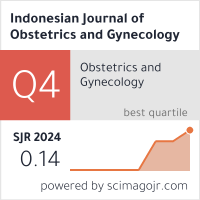The Number of LH Receptor could Predict the Success of Oocyte Maturity in the Process of In Vitro Maturation
Jumlah Reseptor LH dapat Memprediksi Keberhasilan Maturasi Oosit pada Proses Maturasi In Vitro
Abstract
Objective: To evaluate the relationship between the number of LH receptor and the success of oocyte maturity in the process of in vitro maturation (IVM).
Method: This experimental study was conducted in the Permata Hati Infertility Clinical Laboratory, Dr. Sardjito General Hospital, Yogyakarta, with the samples of 300 oocytes obtained through collecting immature cow’s oocytes from the abattoir and grouped the oocytes into 3 (three) groups based on the pattern of oocyte cumulus cells on the vesicle germinal stage 2 - 8 mm with three layers of cumulus cell. The sample of the cumulus cells from these three groups were taken and the LH receptor examination was done with immunohistochemistry. After that, the IVM process was performed to the three groups and its development for 24 hours was evaluated. Its maturation quality was evaluated with the emergence of the first polar body (1PB) and compared to the other groups and related to the number of LH receptor in the three groups. Result: The result of this study indicated that the oocyte cumulus cells showed a difference of function during IVM process. The maturity rate in this study showed that the number of LH receptor was related to the morphological pattern of oocyte cumulus cells with oocyte maturity. The maturity of the cumulus cells which 100% covered the oocyte was higher than that of the cumulus cells which > 50% and < 30% covered the oocytes, namely, 74% compared to 60% and 12%. The result of this study also showed that the average number of LH receptors in the three groups (A, B, and C) was 183.4, 78.8, and 24.0 respectively. A significant difference was found in the three groups (p < 0.0001). When related to IVM maturity, this difference showed that the bigger number of oocyte cumulus cells influenced the oocyte maturity.
Conclusion: The number of LH receptor can be used as a prediction to determine the success of oocyte maturation in the process of in vitro maturation.
Keywords: IVM, LH receptor, oocyte cumulus cell













